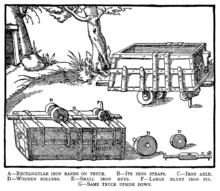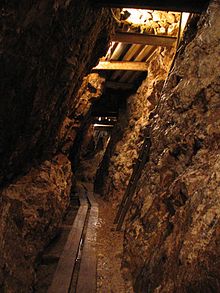


The railway track or permanent way is the elements of railway lines: generally the pairs of rails typically laid on the sleepers or ties embedded in ballast, intended to carry the ordinary trains of a railway. It is described as a permanent way because, in the earlier days of railway construction, contractors often laid a temporary track to transport spoil and materials about the site; when this work was substantially completed, the temporary track was taken up and the permanent way installed.
The earliest tracks consisted of wooden rails on transverse wooden sleepers, which helped maintain the spacing of the rails. Various developments followed, with cast iron plates laid on top of the wooden rails and later wrought iron plates or wrought iron angle plates (angle iron as L-shaped plate rails). Rails were also individually fixed to rows of stone blocks, without any cross ties to maintain correct separation. This system also led to problems, as the blocks could individually move. The first version of Isambard Kingdom Brunel's 7 ft (2,134 mm) broad gauge system used rails laid on longitudinal sleepers whose rail gauge and elevation were pinned down by being tied to piles (conceptually akin to a pile bridge), but this arrangement was expensive and Brunel soon replaced it with what became the classic broad gauge track, in which the piles were forgone and transoms, similar to sleepers, maintained the rail gauge. Today, most rail track uses the standard system of rail and sleepers; ladder track is used in a few applications.
Developments in manufacturing technologies has led to changes to the design, manufacture and installation of rails, sleepers and the means of attachments. Cast iron rails, 4 feet (1.2 m) long, began to be used in the 1790s and by 1820, 15-foot-long (4.6 m) wrought iron rails were in use. The first steel rails were made in 1857 and standard rail lengths increased over time from 30 to 60 feet (9.1–18.3 m). Rails were typically specified by units of weight per linear length and these also increased. Railway sleepers were traditionally made of Creosote-treated hardwoods and this continued through to modern times. Continuous welded rail was introduced into Britain in the mid 1960s and this was followed by the introduction of concrete sleepers.